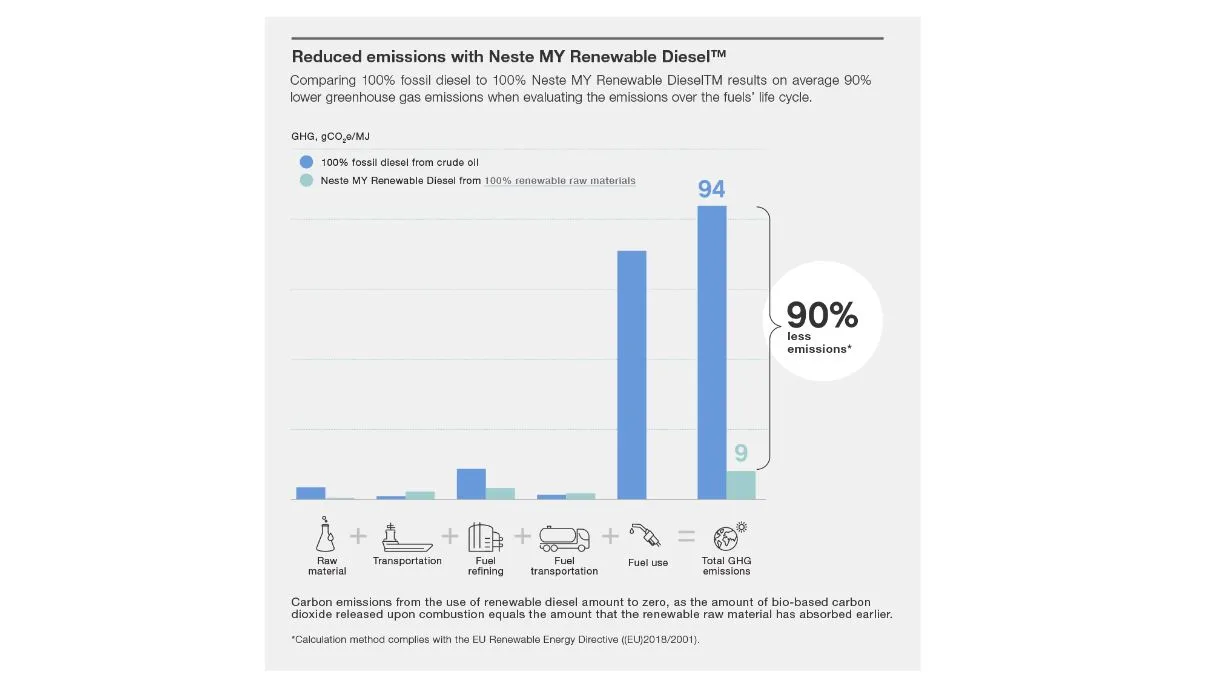
Sustainability
4 minute read
Sustainability glossary: a quick guide to essential climate lingo
There are lots of terms bandied about when talking about sustainability - climate and footprint calculation in particular. But do you know what they really mean? It is important, because if you don’t know the lingo it’s an open invitation for greenwashing – and a barrier to be an active participant in climate action.
Journalist Laura Puttkamer speaks to Sari Kuusisto, Neste’s renewable products’ sustainability expert, to help us understand some of the most common sustainability terms and, importantly, connect the dots around the bigger picture of credible climate action.
CO2 - what does it mean?
There are many emissions and gasses which have an impact on the climate.
Carbon dioxide CO2 is a very common gas and is a natural part of the air all around us - we even breathe out CO2 with every breath. But when we combust fossil fuels, at ever faster pace, there is much more CO2 produced than is good for the natural balance, leading to the greenhouse effect - heat being trapped in the atmosphere, leading to global warming.
CO2e - what does it mean?
Although some greenhouse gas emission calculators focus on CO2, for a full picture the unit to measure greenhouse gas emissions should be CO2e, which stands for carbon dioxide equivalent emissions.
It is an umbrella term for different gasses that have greenhouse effects, including CO2 and other gasses such as methane (CH4), nitrous oxide (N2O) and chlorofluorocarbons (CFCs). Together, they make up greenhouse gasses.
Some of them, for example methane, have a particularly strong greenhouse gas effect and therefore a high potential to increase global warming.
The proportion of the various gasses in the mix depends a lot on the fuel in question - so the significance of each component will vary, and with that the overall impact on global warming.
Greenhouse gas life cycle emissions - what does it mean?
When we talk about a product such as fuel, we calculate its emissions along the entire lifecycle. There are greenhouse gas emissions involved every step of the way from raw material production and transportation to product refining and use and waste management. Looking at all the parts and stages, we get to the carbon footprint of a company or product. It is important to clearly describe what and how you are calculating, because this is the only way to enable the creation of data that is comparable.
There are ways to reduce and save on greenhouse gas emissions. If you use renewable materials, you can cancel out some of the negative effects of greenhouse gas emissions because these are products that trap CO2. Take a tree, for example: When it grows, it needs CO2 for photosynthesis and turns it into sugars and other hydrocarbons and oxygen. This is nature’s own carbon recycling.
Carbon footprint - what does it mean?
Usually a carbon footprint relates to the lifecycle of a product or a service, but it can also be calculated for a business - to do this, you calculate the GHG emissions over the chosen life cycle.
There are legislations and ISO standards that give instructions on how to calculate greenhouse gas emissions or the carbon footprint. One of the global standards is the GHG protocol.
Carbon handprint - what does it mean?
This is a new concept developed in Finland and being adopted by other countries too. It is in some ways a positive twist on the carbon footprint; here, you calculate how much greenhouse gas emission reduction a product or a company can achieve - or the greenhouse gas emission savings that a customer can achieve using a company’s products or services. So in short, a business’ carbon handprint helps its clients reduce their carbon footprint.
Neste's renewable and circular products have significantly lower GHG emissions over the life cycle compared to fossil alternatives. For example, using Neste MY Renewable Diesel produced from renewable raw materials can reduce greenhouse gas emissions by up to 90%* over the life cycle of the fuel compared to fossil diesel.
*) The GHG emission reduction percentage varies depending on the region-specific legislation that provides the methodology for the calculations (e.g. EU RED II 2018/2001/EU for Europe and US California LCFS for the US), and the raw material mix used to manufacture the product for each market.

Credits:
Laura Puttkamer, a freelance urban journalist focusing on innovative solutions that make our cities more sustainable and climate-friendly. Originally from Germany, she is based in London and writes for architecture and planning magazines.
